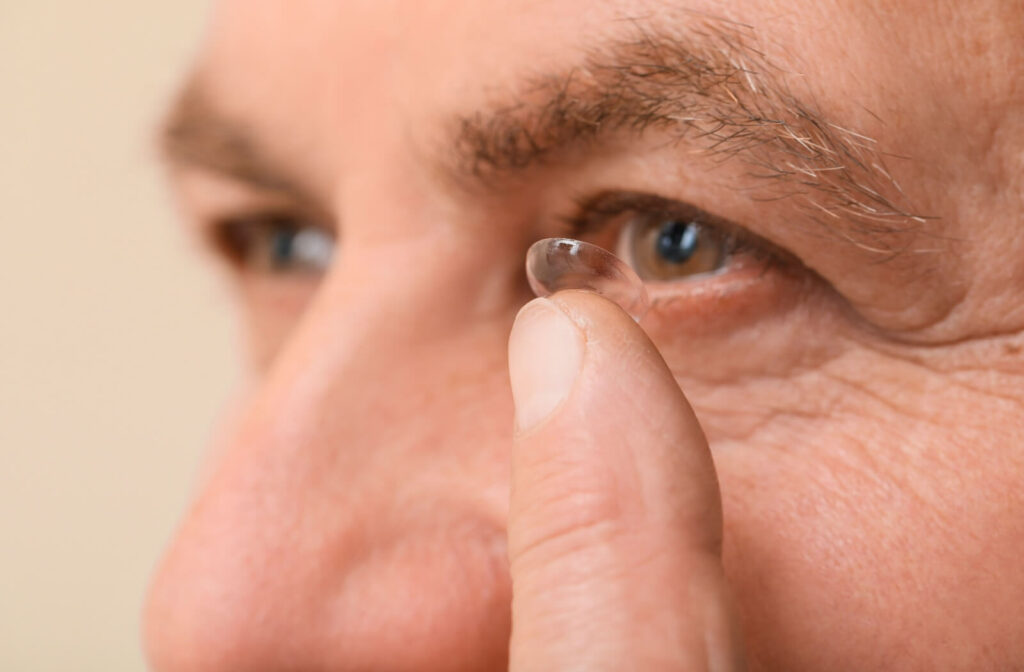Multifocal contact lenses offer a versatile solution for people with varying vision needs from correcting presbyopia to slowing myopia progression.
Multifocal lens technology corrects for vision at multiple distances including reading, intermediate, and distance vision, without switching between different glasses.
They come in one of three designs, concentric, aspheric, or segmented, to address different visual needs and concerns.
What are Multifocal Contact Lenses?
Multifocal contact lenses are designed to provide clear vision at multiple distances. Unlike traditional contact lenses, they help you see both near and far without needing to switch between different pairs of glasses.
These lenses are a great option for individuals with presbyopia, a refractive error that affects the eye’s ability to focus on close-by objects, which generally develops as we age.
Similar to multifocal eyeglasses, multifocal contacts provide multiple prescriptions in one lens. One prescription includes three focus points. The lenses transition into focal points for very close objects, objects at intermediate distances, and objects at a distance.
Convenience is a major benefit of multifocal contacts. It eliminates the need for carrying a pair of reading glasses or switching between different pairs of glasses throughout the day. The seamless transition between fields of vision makes it easy to switch your gaze from nearby work to intermediate distances such as looking at a computer screen.
Another advantage of multifocal contacts includes improved eye health. These contacts have been found to reduce eye strain by minimizing the need for squinting and overexerting eye muscles.
Who Can Benefit From Multifocal Contacts?
Multifocal contacts are primarily used for correcting presbyopia, which begins to develop around age 40.
Multifocal contacts are also a great treatment option for myopia control. Myopia control focuses on slowing myopia progression in children to prevent a high vision prescription. The different zones of focus (reading, intermediate, and distant) help slow myopia progression by reducing eye strain and focusing mechanisms.
Studies show that these contacts can help slow myopia progression in children from 7 to 16 years old.
Even if you don’t have significant vision problems, multifocal lenses can still enhance your everyday life. They offer a convenient way to manage minor vision fluctuations, making daily activities like reading, driving, and using digital devices much more comfortable with one lens, eliminating the need for multiple pairs of glasses.
The Technology Behind Multifocal Contact Lenses
Multifocal contact lenses work by incorporating multiple zones of vision correction into a single lens. Each zone is designed to focus light from different distances, allowing you to see clearly whether an object is close, far away, or somewhere in between.
The lens’s design typically includes concentric rings or a gradual change in power from the center of the lens outwards. Your brain learns to select the correct focus depending on where you are looking. Adapting to this process may take some time.
Multifocal contact lenses come in various designs to address different vision correction needs. They include:
- Concentric Design
- Aspheric Design
- Segmented Design
Adapting to multifocal lenses can take some time. Initially, you may experience slight blurriness or halos around lights, but this usually improves as your brain adjusts to the lenses. Contact lens fittings help determine the most suitable multifocal lenses for your visual needs and the shape of your eye.

Concentric Design
Concentric multifocal contact lenses feature a series of alternating rings of near and distant powers. Similar to a bullseye pattern, these rings can be in a fixed configuration or alternating throughout the lens.
This design is particularly useful for wearers who need distinct zones for different distances, and it is commonly used for people with presbyopia. The concentric design seamlessly helps the eyes shift focus from close objects, such as reading material, to distant objects, such as road signs.
Aspheric Design
Aspheric multifocal lenses blend multiple prescriptions across the surface of the lens, creating a smooth transition between different powers. This gradual shift allows for more natural vision correction, with less distinct blending between near and far vision.
These lenses often mirror the natural curvature of the eye, making them comfortable for extended wear. Aspheric lenses are ideal for individuals requiring seamless transition between distances, providing clear and crisp vision across a range of activities from reading to driving.
Segmented Design
Segmented designs are similar to bifocal or trifocal eyeglasses, where a visible line marks each distinct zone. The lower portion of the zone is corrected for near vision while the upper portion corrects for distance.
Segmented lenses are particularly beneficial for tasks that require a consistent switch between close and distant vision. For instance, switching between the desk to read documents and then looking at the computer screen without swapping eyewear.
Types of Multifocal Contact Lenses
Multifocal lenses aren’t limited to just one type. They come in several forms to suit different preferences and needs. They include:
- Soft Contact Lenses: These are the most common type of contact lenses. They’re made from flexible materials that conform to the shape of your eye, making them comfortable and easy to adapt to. These are available in daily, bi-weekly, and monthly packages.
- Hard Contact Lenses: Also known as rigid gas permeable (RGP) lenses. They tend to last longer than soft lenses, and work well for individuals with high astigmatism, but may take longer to adapt to.
- Scleral Contact Lenses: These are larger than soft or hard contacts because they cover more of the eye’s surface. These lenses are ideal for individuals with keratoconus or severe dry eyes.
Selecting the right type of multifocal lens depends on your lifestyle, vision needs, and comfort preferences. Consulting with your optometrist during your contact lens fitting will help determine the most suitable type of lens for your ocular and visual needs.
Schedule an Appointment
Selecting the right multifocal contact lenses becomes easier after consulting with your optometrist. Connect with our team at Tree City Eyecare to schedule an appointment for your comprehensive contact lens exam and fitting!


